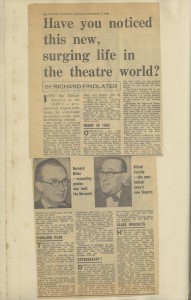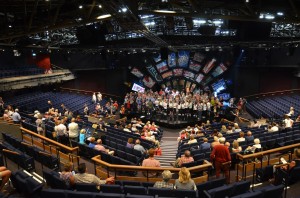
“Have you noticed this new, surging life in the theatre world?”
So begins Richard Findlater’s article (see image to the right), published in the Evening Standard on Monday 14th November, 1960.[1] This particular article captures the excitement and indeed, need, for a new kind of theatre in Britain. As the television set found its way into more and more homes, something needed to change within the world of the theatre to entice the public through auditorium doors. This change is aptly described by Findlater, who writes,
“Into the British theatre of the 1960’s – prematurely looped with crepe by ever-ready mourners – come new bewitching sounds…The sound of unfurling blueprints for new buildings. The sound of men talking about new buildings. And even the sound of buildings being built…TV is supposed to be killing off the live theatre. Yet suddenly there is the stir of new life – not only in plays and players but in bricks and mortar, too.”
Chichester Festival Theatre truly was an exceptional feat of building work, not least because the money raised for the build came from private donations and the local community, who obviously felt the same as Findlater: “We need more theatres and we need new ones.”
At the time the piece was written, funds were still being raised for the build and it was loosely stated that “Chichester may have an open-stage festival playhouse on the lines of the Canadian Stratford.” Construction began a few months later, in May 1961 and in July 1962 the Festival Theatre opened its doors, as a new and forward thinking kind of theatre, both in building and production. Findlater is keen to stress that he’s talking:
“not only about the number but the kind of new theatres. Here, nearly every one of our 200-odd surviving playhouses has only one restricted method of presenting plays – behind the proscenium arch, with equipment that is usually inadequate, before an auditorium split up into outmoded class brackets… Abroad, the new showplaces have flexible and adjustable stages. They are exciting new instruments for the actor, the author and the audience.”

The audience did indeed respond to these ‘exciting new instruments’ and left their television sets behind to find out what this new kind of theatre in Chichester had to offer. It’s an enthusiasm that has stood the test of time, as over fifty years later visitors to the theatre are just as keen to find out more. At our recent Open Day, over 4,000 people came to explore the Festival Theatre, as we offered total access to normally private backstage areas including the scene dock, wardrobe, wigs and dressing rooms, with a theatre professional in each area to explain their work. Visitors also participated in singing, make-up and concrete making workshops and attended talks, events and live performances throughout the site, leaving those television sets resolutely switched off at home.
[1] This one particular article caught my eye after going through the latest set of scans our volunteers have been collecting from a series of scrapbooks kept by Chichester Festival Theatre founder, Leslie Evershed-Martin. This is part of our digitisation work for the Pass It On project, enabling us to discover and unearth such articles to really help us understand the era and setting of when the Festival Theatre was founded.


